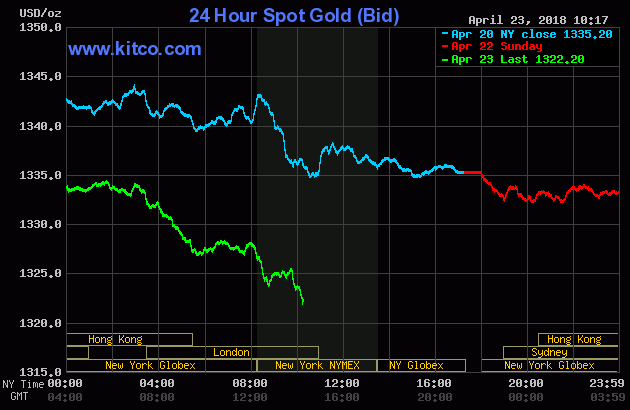Breaking News! North Korea has agreed to denuclearization. Great! But what does it mean for the gold market? And… why is this not true?
Gold Starts Week Badly
The yellow metal struggled on Monday. Its price declined from $1,335 to $1,320, or more than 1.1. percent, as one can see in the chart below.
Chart 1: Gold prices from April 20 to April 23, 2018.

The weakness could be caused by many factors. Many analysts point out Friday’s statement from North Korea that it was prepared to suspend its nuclear program. It sounds reasonable, as denuclearization would reduce the geopolitical risk, diminishing the demand for safe havens, such as gold. But does it really make sense? Let’s dig into this narrative.
Denuclearization Does Not Mean Denuclearization
On Sunday, President Trump tweeted: “Sleepy Eyes Chuck Todd of Fake News NBC just stated that we have given up so much in our negotiations with North Korea, and they have given up nothing. Wow, we haven’t given up anything & they have agreed to denuclearization (so great for World), site closure, no more testing!” The tweet followed Friday’s message: “North Korea has agreed to suspend all Nuclear Tests and close up a major test site. This is very good news for North Korea and the World - big progress! Look forward to our Summit.”
Trump’s comments came as a response to the recent resolution from North Korea titled “On proclaiming great victory of the line of simultaneous development of economic construction and building of nuclear force.” Surprisingly, many journalists published headlines that North Korea had decided to suspend nuclear and intercontinental ballistic missile tests.
Surely, the country declared: “we will discontinue nuclear test and inter-continental ballistic rocket test-fire from April 21.” It might be an important step toward denuclearization, but it is no more than the fulfillment of a precondition for talks. The suspension may imply that North Korean has already learned how to use its nuclear arsenal, so it does not have to test it anymore. Especially that the testing site may have suffered negative environmental effects.
And there is no mention of abandoning the nuclear arsenal. Kim Jong Un makes it clear that nukes remain a “treasured sword”. Surely, North Korea may support the denuclearization of the Korean Peninsula, but it does not mean that it will abandon its nuclear weapons. At least unless the U.S. removes its troops from the Korean Peninsula and the nuclear umbrella defending South Korea and Japan. Hence, although Kin Jong Un may support the concept of a nuclear-free world, it does not mean that it will give up its nuclear weapons without getting anything from the American side.
Implications for Gold
What does it all mean for the precious metals market? Well, nothing. As North Korea did not really pledge to denuclearize, gold shouldn’t be significantly affected. It will not be degraded, just as the rising tensions didn’t boost the price of gold. But even if Kim Jong Un promised it, it wouldn’t shake the price of the yellow metal.
Surely, there might be some temporary effect, as weaker tensions about the Korean Peninsula may reduce the demand for gold. We can see such an effect even now, with only rumors about the talks between President Trump and Kim Jong Un in May or June. A huge progress in diplomatic relations between two countries since last summer. The risk of the immediate nuclear apocalypse is off the table, fair enough.
However, as we showed in the September edition of the Market Overview, gold’s reactions to geopolitical tensions about the country ruled by the Kim dynasty have been usually short-timed and limited.
Hence, it seems that the recent declines in the price of gold had more in common with the spiking U.S. dollar and bond yields approaching 3%. Macroeconomics trumps geopolitics. We will analyze these developments for you in the upcoming editions of the Gold News Monitor. Stay tuned!
Disclaimer: Please note that the aim of the above analysis is to discuss the likely long-term impact of the featured phenomenon on the price of gold and this analysis does not indicate (nor does it aim to do so) whether gold is likely to move higher or lower in the short- or medium term. In order to determine the latter, many additional factors need to be considered (i.e. sentiment, chart patterns, cycles, indicators, ratios, self-similar patterns and more) and we are taking them into account (and discussing the short- and medium-term outlook) in our trading alerts.
